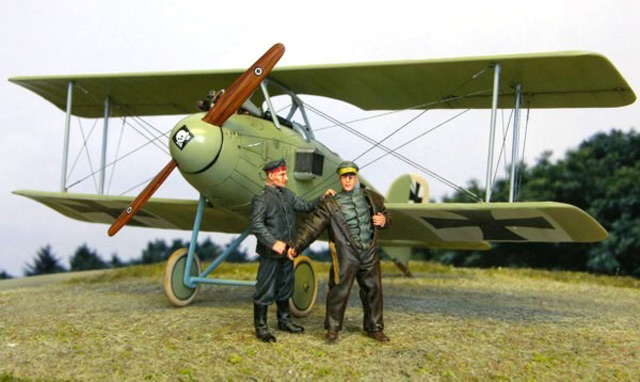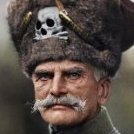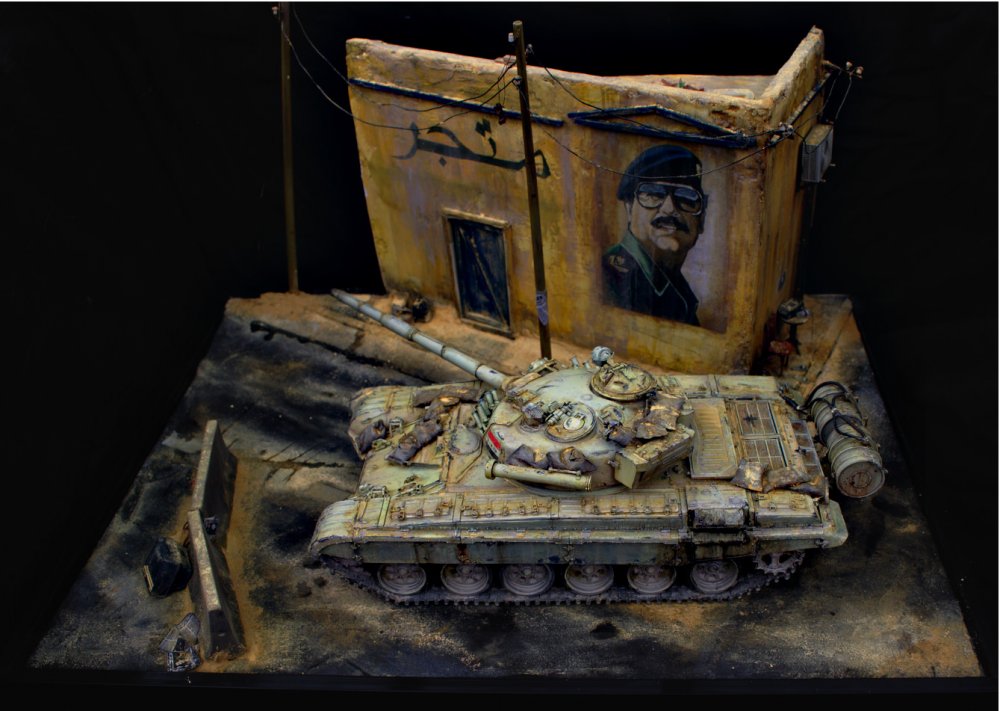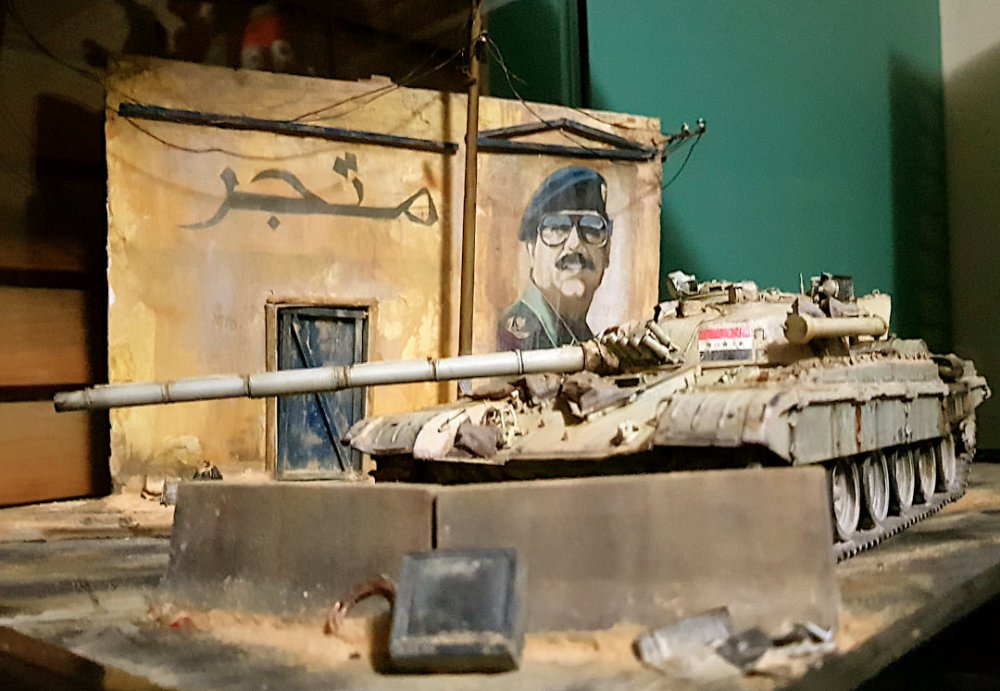-
Posts
6,396 -
Joined
-
Last visited
Content Type
Profiles
Forums
Events
Gallery
Posts posted by GazzaS
-
-
8 hours ago, Peterpools said:
Gaz
Shading looks spot on
Keep 'em comin
Peter
Thank you Peter!
-
 2
2
-
-
11 hours ago, DocRob said:
I like your shadowing Gaz, the green hue is part of the palette of colors used, so that's fine by me. I experimented a lot with oil colors and pigments year the last year and found, it's best to stay in the array of colors used for shading or use vibrant often contrary colors, which involved pink orange and violet tones in some cases. You can learn a lot about color techniques and shading from good figure painters, some of them seem to have found the holy grail of color rendition.
Another important thought is always 'go with the imagined lighting', nothing looks worse than false shadows.Cheers Rob
Thanks, Rob. I appreciate your input. False shadows seem part-and-parcel of modelling nowadays. It's basically what is often done with a pin wash. Creating a shadow around a detail to bring it to the fore. I've always been fascinated by artwork where a color is illustrated without that color even being used.
-
 3
3
-
-
Welcome back hombres!
AS promised... another update.
Every once in a while you meet someone in the modelling world who rocks your modelling conceptions to their very foundations. One day I met this guy named Steve over at Armorama. Another Aussie, he did things far and away different from the old standards of dot filters, and pre-shading. He would do fantastic things with armor models, and you wouldn't even realize how he reached spectacular finishes unless he told you. Though I've lost contact with him, with each model I try to find ways to do things like he might have.
For instance... in the below photo... He used a pink filter in places on this T-72
This color rich tableau has has inspired me to move beyond the more traditional weathering steps. I know I haven't reached his level, yet. But I hope to someday.
So....here's what I've been up to.
On the ventral curved surfaces, at the base of the vertical stabilizer, and at selected areas of the struts, I used green oil paint to add shadow. I don't really know if I'm sold on the green. I'm hoping you guys will offer some insight if I've failed.
On the curved dorsal surfaces, the top of the vertical stabilizer and selected areas on the struts, I've used a buff colored mixture in oils to lighten and highlight the line between the slab sides and the arched top.
In this photo the dark shade at the bottom of the vertical stabilizer is lightly more prominent... I've also made small shadows under the 'ear' radiators and under horizontal stabilizers.
In this final photo, there isn't much worthy of remark except for a couple of smudges I used between the wings to add shape that normally isn't picked up by the camera.
Happy modelling!
-
 7
7
-
-
15 hours ago, KevinM said:
All I can say is "Nice!"

Thank you, Kevin!
-
 3
3
-
-
16 hours ago, Peterpools said:
Gaz
On my monitor I'm seeing the black now leaning towards very dark gray and the white leaning towards a very pale gray, which both seem fine to me.
Keep 'em comin
Peter
Thank you, Peter!
15 hours ago, Kaireckstadt said:Gary, my comrade in the right sense
 ,
,
To my personal opinion the weathering of the black and white looks absolutely realistic! Exactly the way I like it: subtle and not exaggerated! I think this will also be visible under a matte cote.
Not far away from the finish-line, Gary! Maybe you already cross it on Thursday?
Thank you Kai. There's no way it will be done Thursday, as much as that would be nice. Tonite, I hope to paint the dorsal fuselage with oils and set it to dry. Then if dry tomorrow, I will clear coat the fuselage. After that, the pin wash. Yes... still gotta have a pinwash. Though I'm still debating the colors. Thankfully, the other D.I's I posted on the previous page show that neither black nor brown is the right color for the job. I will mostly use a darker shade of the fuselage color.
Anyway, the oils for tonite are seeping linseed oil into some rough cardboard and hopefully I'll find time tonite to do the area I want.
-
 3
3
-
 1
1
-
-
G'day Comrades... not in the Socialist sense, though. But in styrene.
On work days, I have little time or energy for modelling. But I did continue work on the wing. My key goal was subtlety. White and black have different rules from other colors, I believe. White reflects light while black absorbs it.
And effects need consistency to be believed. But I was very apprehensive about attacking the cross fields on the upper wing. So... I have no way to know how this will look once a matte coat is applied. Here is a collage of the upper wing crosses:
I worked on the fuselage today, but no pics. I'm trying to use oil paints to bring out the unique shape of the fuselage.
I have Thursday off... I hope to accomplish something noteworthy then.
Happy modelling!
-
 6
6
-
-
7 hours ago, HubertB said:
I could venture that WnW would have sold more Spad XIII and Caudron G-3 than Gotha G1 and UWD, and maybe would still be around... But then, that’s just me looking for trouble

Well done CSM !
Hubert

Anything but fighters was a huge mistake until they ran out of well-liked fighters to make.
-
 5
5
-
-
Some great work already, Johnny B! Color me interested!

-
 4
4
-
-
Great job, Kai! A huge transformation from what the LG once were! Now, you're getting close!
-
 5
5
-
-
What caught my eye was the figures for the Tamiya 1/35 scale Pz IVG. They look really nice and natural.
-
 6
6
-
-
3 hours ago, Clunkmeister said:
To me, in the 50s, this has always been the epitome of high style.
1957 Ford Fairlane 500 Skyliner.
It makes that Bel Air look positively dumpyslide the hardtop back into the trunk and you have the ultimate cool car. I’d lose that goofy Continental spare wheel though, factory option or not, it looks stupid
But it was all about the Douglas!
I really don;t care much for older cars. Maybe a 63' corvette split window or maybe a 71 camaro splut bumper. Older cars are just novelties, really.
-
 4
4
-
-
1 hour ago, Jeff said:
Even though Phil put me in the back row, I am feverishly taking notes for my build, and this is an awesome tutorial, for me to try to expand my mediocre skills
51 minutes ago, Peterpools said:Gaz
Outstanding results with the oil weathering - light and subtle ... it's there and for me, adds to the depth and feel of the model.
Gaz, thanks so much for the tutorial ... I've been struggling with just this weathering effect and am going to give it a whirl on the interior of my P-39 and see how it goes.
Keep 'em comin
Peter
Thank you, fellas! I am glad to be of help.
-
 4
4
-
-
This is really more about the Douglas....

-
 2
2
-
-
Just now, Kaireckstadt said:
Thanks for this super tutorial Gaz.
I can print this out and use it as an instruction!
And at the end it is possible to seal everything with flat varnish?
You are welcome.
Yes, you can seal everything in flat varnish. I usually give the oils a week to dry before I add any other effects or coats. Be sure before you use the oils to place them on a piece of rough card-board and let them sit for three hours to leach out the linseed oils in the paint. Otherwise... it can take a very long time for the paint to dry.
-
 3
3
-
-
2 hours ago, DocRob said:
The oil treatment turned out great. It results in a very realistic look. I like the little differences in the three camo colors, which enhances the realism to my eye.
Cheers Rob
Thank you, Rob!
-
 3
3
-
-
2 hours ago, Kaireckstadt said:
Great and subtle weathering with the oils Gaz! Looks really convincing!
Can you describe what you do with the oil streaks on the surface? Is it thinned or plain? Which basic colors do you use for mixing? How do you apply it and how long does it have to dry?
I want to give it a try. You also used this on your beautiful 190 didn‘t you?
Thank you, Kai!
This work was done without applying a clear coat, and the paints are MRP lacquers. A gloss coat will make the oil paints spread too quickly as they won;t have anything to grab. I suppose you could use a satin coat, but why add another layer of paint?
The initial streaks are thinned to a creamy consistency. If you find yourself having trouble spreading the paint with a dry brush, just wipe it off with a clean paper towel and thin your paint more and do it again. I use odorless turpentine as my thinner.
I applied the paint with a paint brush dedicated to the job of solely applying paint.
Then I used a flat (7mm-8mm), dry, synthetic brush to spread the paint where I wanted. If I found I had too much paint, then I used another brush dipped in mineral spirits to remove some paint. The moral of this part of the story is that you really don't know how much paint you want until you see how it is spreading.
Occasionally you need to clean out your dry brush with mineral spirits... or your thinner of choice. Mineral spirits dry fast, so that is what I prefer. Using your dry brush while it is damp will cause you to remove paint instead of spreading it.
AS far as colors go, you have to determine your goal. If, like on a metal-skinned aircraft, you are trying to modulate the color, you can use any variety of colors really as you are spreading that paint so thin as to make the color you've applied disappear. But on this occasion I was trying to effect a shape change with three different base colors on a fabric skinned aircraft, with colors that specifically had to be darker versions of the colors already applied.
For the grey-green, I just mixed black, white, and green. For the green I mixed green, blue, and yellow ocher. And for the brown, I mixed dark brown, red, and blue until I got a deep chestnut color. With oils, you can afford some experimentation as long as you try to find the right mix as long as your colors aren't too different from each other. For instance, if you used red over white, no amount of cleaning afterward is going to remove a pink stain.
:max_bytes(150000):strip_icc():format(webp)/chestnuts-58410_960_720-5820d8345f9b581c0b7da0fe.jpg)
Do they have chestnuts in Germany?
Finally... if you go out of the area you want your color to be in, you can use a brush dipped in white spirits to try to remove it. I actually got some red into the white around the kreuzen and will have to use paint to cover it.
Regarding the FW 190 there was more to it as I modulate both with the airbrush by changing the base color a few times by tinting with complimentary colors of the same brand of paint.... and then I wet sand afterwards to make it smooth which also stresses the paint scheme and randomizes the finish. And all of this before I was even thinking about what I would be doing with oils.
-
 4
4
-
-
On 5/13/2021 at 11:37 AM, Clunkmeister said:
The last big order I placed took 9 months.
Isn't that just about how long it took the US Army Corps of engineers to dig the Panama Canal?
-
 3
3
-
 2
2
-
-
So cool! Well done!
-
 3
3
-
-
On 5/14/2021 at 8:44 AM, Peterpools said:
Gaz
Looking so good ..
Keep 'em comin
Peter
Thank you very much, my friends!
Today's effort was with oils... almost all day long. This crappy phone shot shows the beginning of the technique. I laid oil paints, lightly thinned, between the raised ribs of the flying surfaces.
Now... I have tried to get this effect with pre-shading, and I've never been happy with it. Maybe I just lack the knack. Anyway....
And I had to mix a separate color for each of the colors on the fabric surfaces.
And now we can jump to the results:
I wanted the effects to be subtle, yet not too even. In pics, you can barely see what I've done with the rudder. The large pattee cross gives little room for messing around. I still have to attack the area of the wing crosses.
Happy modelling!
-
 4
4
-
 2
2
-
-
Even better, Kai! Do you find it difficult to find pledge/Future in Germany?
-
 3
3
-
-
I can only echo what Kai says. Really great progress!
-
 4
4
-
-
Thank you, Peter!
-
 3
3
-
-
19 hours ago, Peterpools said:
Gaz
Awesome, simply awesome work and what a collection: museum quality.
Keep 'em comin
Peter
9 hours ago, GusMac said:Looks great Gaz
 9 hours ago, harv said:
9 hours ago, harv said:Don't know how, but this dropped off my radar. Gazz , it looks amazing sir !!.....harv
Thank you, my friends!
-
 4
4
-
 1
1
-
-
19 hours ago, Kaireckstadt said:
I can only underline what Rob already stated:
The details and your work make a real stunner out of it!
Great looking model Gaz! I personally love the prop with the skull on the spinner!Thank you, Kai. I'm still unsure about what to do with the spinner. It just seems silly to have the skull on a rectangular background. And I have seen no real pictures of it. It would be far easier to have the skull on a circular background, and must have been difficult to do IRL.
Here is another modellers take on it.

Apparently, it was known in the unit as "Der Grun Maus".
A new photo I just discovered, but it doesn't help with the prop:

Perhaps my skull is too large and or on the wrong background....

Of course there is speculation about the wings, whether they were left in factory standard as I have painted them, or all-green as others have.
So... whatever happens...
-
 4
4
-







Roden Albatros D.I
in LSM 1/35 and Larger Work In Progress
Posted
Thank you Kai. I was definitely happier with the top result than the bottom. I may blend in some gray to soften the impact of the green. The buff area isn;t really a shadow, it's more an effect of more light catching the upper areas.